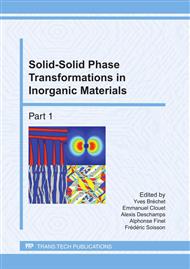p.309
p.315
p.321
p.331
p.338
p.344
p.350
p.356
p.362
Study by Differential Thermal Analysis of Reverse Spinodal Transformation in 15-5 PH Alloy.
Abstract:
Alloy 15-5 PH is a stainless steel with 15 wt.% Cr and 5 wt.% Ni that is precipitation hardened by addition of Cu. In its semi-finished state, this alloy consists in Cu-supersaturated soft martensite; its high specific properties come from a final tempering consisting in a heating to 550-600°C, holding for 4 hours, and then air cooling. This treatment leads to nanometric Cu precipitation that hardens the material and to transformation of some martensite to reverted austenite which is then stable and provides ductility. While a' embrittlement of such steels is known to occur at temperature in the range 450-520°C, it has been reported that they can be sensitive to the same phenomenon after long term ageing at temperature as low as 300°C, with a significant loss of ductility and an increase of the ductile-to-brittle transition temperature. Atom probe studies showed that this degradation is related to demixtion of martensite into Fe-rich and Cr-rich phases. Depending on the ageing temperature, demixtion can proceed through a nucleation and growth precipitation or by spinodal decomposition of the martensitic matrix. The present study reports differential thermal analyses (DTA) performed upon heating samples of material held at various temperatures (290-525°C) for various times (410 h to 8500 h) that have been characterized by atom probe. A clear DTA signal is obtained upon the reverse spinodal transformation that is further found to depend on ageing conditions.
Info:
Periodical:
Pages:
338-343
Citation:
Online since:
June 2011
Authors:
Keywords:
Price:
Сopyright:
© 2011 Trans Tech Publications Ltd. All Rights Reserved
Share:
Citation:


